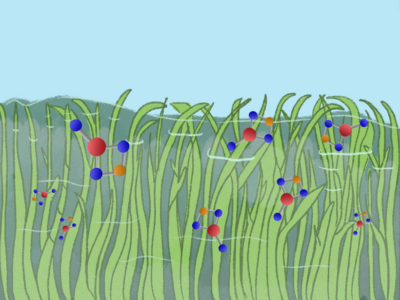Aquatic Plants May Help Chesapeake Bay Resist Ocean Acidification
In freshwater vegetation flats upstream of the Chesapeake, chemical reactions create molecules that raise pH levels in the bay.

The Chesapeake Bay stretches nearly 325 kilometers north to south and is 8 kilometers wide in some places. The riparian habitat is home to mammals like bears and river otters, hundreds of species of birds and fish, bottlenose dolphins, and even manatees. The seafood industry in Maryland and Virginia generates more than $3 billion per year and supports more than 30,000 jobs.
In the late 1960s, the bay was plagued by pollution and the loss of submerged aquatic vegetation (SAV). Although conservation efforts have restored SAV beds and improved the overall health of the bay, it’s still experiencing local effects of climate change: rising temperatures, oxygen-free dead zones, and acidification. Although the bay’s surface reaches pH levels around 8.2, its subsurface pH can be as low as 7.4.
Now, researchers think that restored SAV beds upstream of the bay could be a key player in the fight against acidification.
“This is a very interesting thing,” said Wei-Jun Cai, a marine chemist at the University of Delaware and coauthor of a new study in Nature Geoscience, in a statement. “People talk about ocean acidification and very rarely talk about what resists it, what can buffer the system against ocean acidification. So that’s what we want to find.”
Carbon Dioxide Double Whammy
Two sources of carbon dioxide (CO2) acidify the Chesapeake Bay, Cai told Eos. One source is the atmosphere, which is full of anthropogenic CO2 emissions. The ocean has absorbed roughly a third of that CO2. Subsequent chemical reactions acidify the ocean water, hampering marine animals’ ability to build their skeletons and shells.
The second source of carbon dioxide comes from below the bay’s surface, as a secondary effect of eutrophication, Cai said. Eutrophication occurs when nutrient-rich waters encourage algae blooms and those algae die and decompose. The decomposition of the algae leaches oxygen out of the water, leading to dead zones where animals can’t survive.
Eutrophication also releases carbon dioxide.
“Whether the carbon dioxide comes from organic matter decomposition or from an anthropogenic source, it has the same effect,” which is acidification, Cai said.
Plants as Buffers
While studying the Chesapeake Bay’s pH levels, Cai noticed heightened levels of calcium carbonate dissolved in the subsurface of the bay. At that time, he had no idea where the calcium carbonate came from. One thing was for certain: That carbonate was most likely acting as a buffer to keep the bay’s pH from dipping too low.
“If not [for] the carbonate dissolution, the pH could go down to 6.8. Really, really low,” Cai said.
After seeing a conference talk about submerged aquatic vegetation, Cai wondered whether something upriver was releasing the calcium carbonate.
So he and his team set out to the Susquehanna Flats, a shallow region upstream of the bay that’s home to an abundance of submerged vegetation. In testing samples from the dense vegetation beds, the researchers found that photosynthetic processes raised the water’s pH and oxygen levels, thus allowing more carbonate to form. The researchers also took plant samples and analyzed leaf surfaces in the lab, where they found nanometer-sized calcium carbonate crystals under an electron scanning microscope.
Models suggest that the carbonate is produced in the shallower water of the flats and then is washed downstream into the bay, researchers said.

The paper offers “a previously overlooked mechanism in which restoring the SAV beds will likely enhance the buffering capacity of the mid-bay, potentially providing further resiliency in the face of global ocean acidification,” said Iria Gimenéz, a researcher at the Hakai Institute in British Columbia, Canada, who wasn’t involved in the research (although she has worked with the authors before).
Cai said that going forward, he wants to better understand the mechanism by which the calcium carbonate reaches the mid-bay region, how long that process might take, and under what conditions this flushing happens.
—JoAnna Wendel (@JoAnnaScience), Science Writer
Except where otherwise noted, images are subject to copyright. Any reuse without express permission from the copyright owner is prohibited.








 User Center
User Center My Training Class
My Training Class Feedback
Feedback












Comments
Something to say?
Log in or Sign up for free